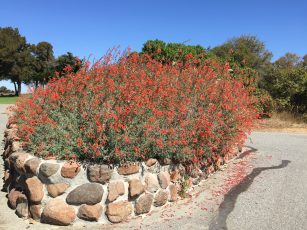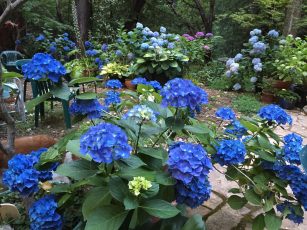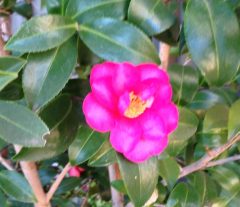Those of you who lived in the Santa Cruz mountains during the winter of 1982 remember it well. Following two days or torrential rains, a large section of hillside above Love Creek gave way. Thirty homes were destroyed and ten people were killed by the slide. The rainfall totaled 111 inches that year.

During the winter of 1997 the San Lorenzo Water Department recorded 90 inches of rain. The department?s historical rainfall data goes back to 1888 and shows that during the winter of 1889 a whopping 124 inches of rain fell. This winter is one to rival the books with about 70-110 inches of rain falling so far depending where you live. We don?t aspire to break any records.
How does this much rainfall affect our gardens? If you have addressed drainage issues and are slowing, spreading and sinking all this water, congratulations. But what about the plants? Fortunately most plants are dormant or semi-dormant at this time of year. Even plants that don?t lose their leaves aren?t in growth mode yet. When a plant is actively growing either roots or new foliage it will suffer if the roots are soggy day after day. Fungal problems and root rot will take its toll on a plant. An extremely wet March or April is not a good thing.
We gardeners are the eternal optimists and hope that only gentle rains will fall through May. And during those lulls in the weather this is what I?m going to be doing over the next month.

Prune fruit, nut, shade trees and deciduous vines like clematis. Cut back woody shrubs like Mexican bush sage, artemisia and butterfly bush to stimulate lush new growth. You can cut back these plants close to the ground. Don’t use this approach on lavender or ceanothus, though. Prune them lightly after blooming without cutting into bare wood.
Prune fuchsias back by a third and remove dead, crossing branches and interior twiggy growth. Container fuchsias can be cut back to the pot rim.

Cut back hydrangeas stems that bloomed last year and apply a soil acidifier if you want the flowers blue. Although sulfur is the traditional favorite for quickly acidifying soil it is not as kind to many beneficial soil microorganisms. Coffee grounds, pine needles, peat moss and cottonseed meal are better for your soil.
I?ll wait to prune back perennials that may have their new foliage damaged in a late frost. Already damaged foliage can protect a plant from further frost damage. Mid-March is the estimated date of last hard frost in our area. Or at least it used to be.
Don’t cut back grasses yet if you get frost in the area where they grow. Wait until mid-March. If you live where you rarely get frost go ahead and prune these plants back now. I?m going ahead and pruning California fuchsia, salvia ?Bee?s Bliss? and hummingbird sage now. They look terrible.

Don’t prune spring flowering shrubs and trees like lilacs, flowering cherries, plums and crabapples, rhododendrons, azaleas, camellias, weigela or spirea until after they flower. You can cut some branches during flowering to bring in cuttings for bouquets.
I can tell that spring will soon be here as the flowering plum buds are showing color. Can?t tell from the weather report, though.
